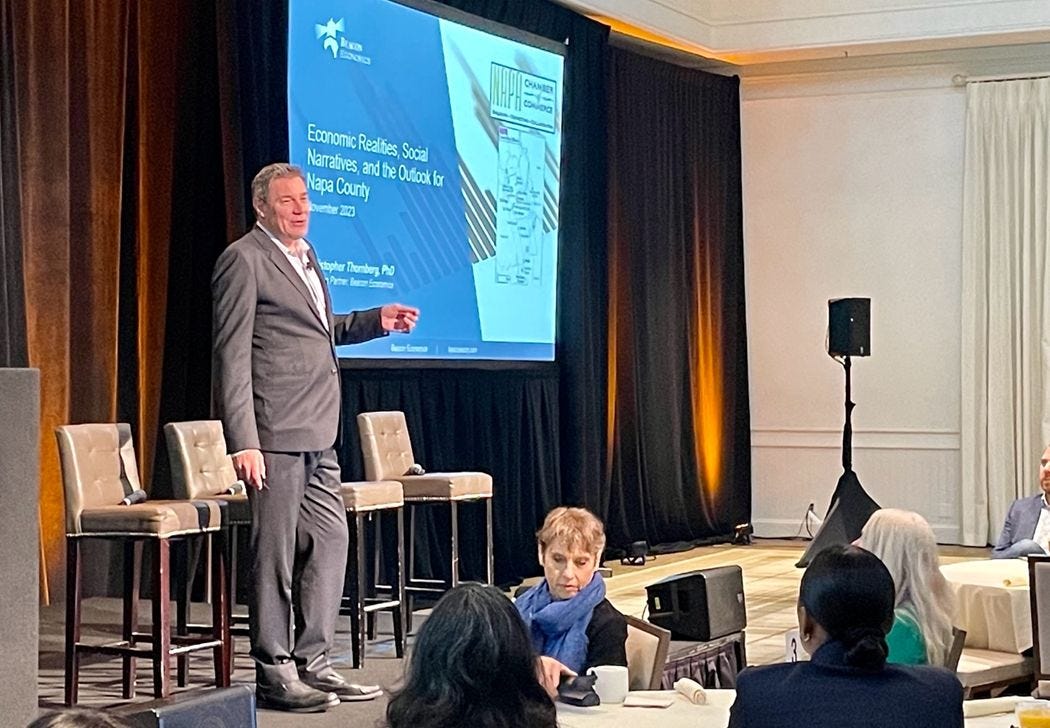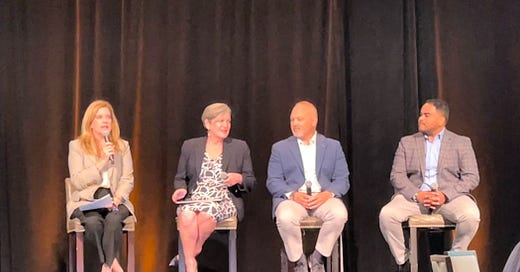Napa Chamber welcomes business, industry leaders for economic outlook conference
By John Dunbar
NAPA, Calif. — After a nearly decade-long hiatus, Napa’s Economic Outlook Conference made a comeback in November.

Hosted by the Napa Chamber of Commerce and moderated by its president and CEO Jeri Hansen, the event connected peers, policymakers, and industry leaders and featured experts and thought leaders who offered insights into current economic trends and forecasts.
Approximately 150 people gathered at Silverado Resort and represented an array of industry sectors, including health care, finance, wine, housing, hospitality, local government and tourism.
“Our world is evolving at an unprecedented pace, and it's crucial for us to plan and be prepared,” Hansen told conference attendees during her opening remarks. “Today's conference is not just about numbers and forecasts. It's a platform for us to collectively explore opportunities, anticipate challenges, and foster the kind of innovation that propels our businesses and community forward.
“As members of the business community, we understand the power of partnerships. It's the collaborations between businesses, government agencies and community organizations that create a resilient economic ecosystem.”
The keynote address from renowned economist Dr. Christopher Thornberg of Beacon Economics focused on forecasting, economic policy, and labor and real estate markets. According to Thornberg, data show positive economic conditions, not the doom and gloom frequently reported on news and social media platforms. He warned about “the philosophy of pessimism” that can present narratives that may not be fact-based or thorough.

“It isn’t just that they have survived inflation and interest rates – Americans are having fun. Just look at what’s going on out there,” Thornberg told attendees. Nationally, while labor markets remain “tight,” unemployment is below 4% and what he described as “real wage growth” remains positive. In the restaurant industry, he explained, spending is up 38% since the pandemic. “It’s amazing how strong this economy is,” he said.
Looking at Napa’s economy, he noted things have settled down over the last year, but that was after what he called “a big surge” in sales across several industries. Wineries remain a strong sector, with an 18% increase in revenue for grapes in 2022 over the previous year. “A lot of that has to do with the high quality of Napa grapes. This place continues to grow some of the best grapevines in the world.”
Dr. Robert Eyler, a respected economist specializing in the North Bay region, offered a “crystal ball” glimpse into Napa’s business past, present and future based on trends, emerging market activity and risk management with a focus on how these translate locally.
Napa’s economic foundation is made up of health care, hotels, restaurants, retail and an array of professional services. Collectively, the business community needs to decide how to maintain a relevant and vibrant local economy, especially as regional, national and global travel destinations have become even more competitive with Napa Valley, Eyler noted.
“If you think about the status quo, is Napa OK with a continued focus on hospitality and wine? What concerns would you solve by going down a path that’s more diverse?” Eyler asked the audience.
“If you diversify … would Napa’s economy benefit from other manufacturing, science-driven professional services, conferences or other industries linked to agriculture and wine? Industry changes are inevitable, but the timeline will vary depending on economic conditions,” Eyler said.
A panel of workforce and education professionals discussed using sector partnerships for business and career development. Barbara Halsey, CEO of Halsey Consulting, focused on how a Next Generation Sector Partnership model can avoid a disconnection between employers and workers and the education, economic and workforce development organizations tasked with supporting them. Instead of seeking programs or grants made available by the public sector, industry leaders are at the center and define their own agendas. Public-sector partners respond in order to provide the requested resources.
“Tell us what your opportunities for growth are … tell us what your future looks like and what you’re excited about for the future,” Halsey said. “Now, tell us what needs to happen in order for you to realize those opportunities, and help us understand what you’re willing to do in order to make sure we leverage every capability we have in this community to provide you with the greatest access and opportunity for success that we possibly can.”
She said that if businesses are able to grow and create quality jobs, the economy benefits. If people can access quality jobs, the community benefits and industries can chart their own best futures using this model.
Rounding out the day’s program was “The 5 x 5,” an introduction to five emerging topics that are transforming business norms: a new local business incubator and accelerator, a regional venture-capital fund fueling North Bay startups, what makes an equitable enterprise, the value of measuring social impact, and ways to create a healthy life and work balance.

Attendees provided feedback that valued the professional analysis and the call to action for a collaborative plan for Napa’s business future.
“I have so much respect for the Chamber and the local business community they represent,” said Napa County Supervisor Ryan Gregory. “I saw so many old friends at the meeting, some of whom I haven’t seen since before the pandemic. Aside from seeing my good friends, the content was great — the real skinny on what is happening now and what to expect in the economy ahead. As your second district county supervisor, I have taken all this back to my team to make sure our government supports our businesses.”
Bernie Narvaez, city of Napa council member and a Napa insurance business owner, attended to hear from experts and other business leaders.
“It was a refreshing take on our economic situation. The speakers provided data that told a different and better story than what we hear in the media,” Narvaez said. “Diversifying our economy in a way that complements our wine and hospitality industry will help the challenges we face.”
Ricky Hurtado, community outreach manager for CommuniCare+OLE, attended the conference to learn about the direction of Napa County’s economy and apply that knowledge to help support his work in health care.
“Having the Chamber of Commerce do events like this helps leaders get a true understanding of our economy through an outsider’s perspective of our community,” he said. “Additionally, it was important to see where Napa Valley lies compared to its competitors like Sonoma and San Luis Obispo counties and other destination locations like Europe. Because of the valley's nature, we need to continue supporting our wine and lodging industries, but we need to look at ways to diversify our economy simultaneously. This doesn’t mean that one supersedes the other, but it is part of diversifying the local economy that can continue supporting our residents and visitors alike. … A great first step is having conferences like this, where we gather individuals from cross-sectors to understand our economy better. The next steps are to have a space to discuss ideas, continue the conversation and have actionable items — almost like a strategic plan.”
Bruce Wilson, executive director of Workforce Alliance of the North Bay and a conference panelist agreed.
“The event was incredibly informative and packed with information and data that was relevant, on point and illuminating,” he said. “It also was helpful to know that the challenges we face are solvable and filled with opportunities for our community. Dr. Thornberg mentioned ‘It’s a choice,’ and I couldn’t agree with him more. And the best choice we can make, in my opinion, is begin now in partnership to engage those challenges.
“I felt like attendees walked away from the event invigorated about the future,” he continued. “Not because the future was without challenges but because they believed that our community could solve those challenges by working together in a planned, systemic way. This systemic approach was specifically addressed in the State of the Workforce panel that stressed authentic and collaborative engagement with industry at the center of the conversations.”
Hansen encouraged the audience to champion the lessons shared throughout the conference and take meaningful steps to support the long-term viability of Napa County’s economy and community.
“It’s about economic development and how we define that,” she said. “In our community, everything we talked about is economic development, so when we start tagging education and workforce and housing and childcare as under the tent of economic development, then we start solving problems.”
John Dunbar is the former mayor of Yountville and served on the Yountville Town Council for 18 years.




